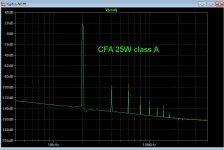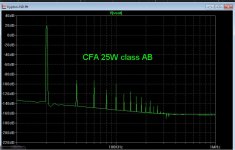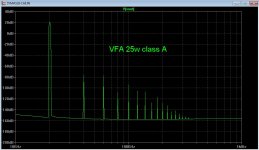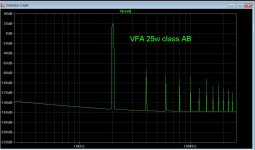So you won't even click a link until I drive a bentley for 6 months, yet you were the one who asked for an example of state of the art in audio? Curious.
Gosh! Bill, it only weighs 7kg. How can it possibly be SOTA?
Kaluga
An externally hosted image should be here but it was not working when we last tested it.
In the 70s when working at Audio Dimensions/Audio Directions we got the Threshold 400a in and had it in rack with inputs paralleled with Dynaco Stereo 80 out of sight behind that was actually connected to the speakers. Everyone that listened watching the led display on the Threshold bouncing to the music said how wonderful the Threshold sounded.
No, I would expect I would have difficulty telling the difference between a Dyna ST120 and something else with a standard DB test. However, listening to one over time is the key to knowing the quality of a solid state design.
In 1969, I purchased my first commercial solid state amp to drive my K-horn. It was a Marantz 14. Actually, it was a pretty good design, measured very well, and was unconditionally stable with cap loading. I did my own measurements.
At first I was impressed with the performance, but over time I found myself turning off the hi fi, rather than having it in the background (usually FM radio) while I was doing other stuff. Yes, the amp was giving me listening fatigue. I switched back to the Dyna MK-3, and even to my own solid state prototype, and both sounded better over long term listening. Why this is so, I cannot say. I know that the Dyna MK 3 had some measurable distortion at listening level, but neither the Marantz 14 or my prototype did with the IM equipment we had to measure with (.005%) at the time. Today, if I had a Marantz 14 available, I could probably find the problem, but now I have better test equipment, but I can't be sure. Personally, I was impressed with the Marantz 14, construction and performance, but it just fatigued me over time. For the record, the BEST amp of all that I previewed on the K-horn was a Radiocraftsman from the early '50's designed by Sid Smith. I could have listened to it indefinitely. My solid state prototype wasn't half bad either.
In 1969, I purchased my first commercial solid state amp to drive my K-horn. It was a Marantz 14. Actually, it was a pretty good design, measured very well, and was unconditionally stable with cap loading. I did my own measurements.
At first I was impressed with the performance, but over time I found myself turning off the hi fi, rather than having it in the background (usually FM radio) while I was doing other stuff. Yes, the amp was giving me listening fatigue. I switched back to the Dyna MK-3, and even to my own solid state prototype, and both sounded better over long term listening. Why this is so, I cannot say. I know that the Dyna MK 3 had some measurable distortion at listening level, but neither the Marantz 14 or my prototype did with the IM equipment we had to measure with (.005%) at the time. Today, if I had a Marantz 14 available, I could probably find the problem, but now I have better test equipment, but I can't be sure. Personally, I was impressed with the Marantz 14, construction and performance, but it just fatigued me over time. For the record, the BEST amp of all that I previewed on the K-horn was a Radiocraftsman from the early '50's designed by Sid Smith. I could have listened to it indefinitely. My solid state prototype wasn't half bad either.
I have to say that when I dealt with the 120 I was not involved in audio per se, other than being the studio engineer for less than a year for the electronic music studio (while working the much-preferred job in the astronomy dept.). I think around that time I was still living with my parents, and my father did do audio installations. At one point he upgraded some client's system, and was given the old stuff. So we had a JBL SA600 for a while, Bart Locanthi's attempt at a decent SS design (despite the unsuccessful pursuit of a patent on the "T-circuit"). I recall the loudspeakers were pretty poor. But the system was passable. I wasn't complaining about the amp, nor was my father, at least until the cadmium-plated RCA jacks began to get intermittent sleeve connections, which my father always attributed to electrolytic caps needed to be re-formed, and he would cycle the power to make the audible hum go away --- which years later I realized was just introducing a transient that cut through the muck on the connectors.
My reaction to the Dynacos I encountered was not preconditioned by scrutiny of the topology, and I found the voltage regulators puzzling. But although they didn't sound immediately God-awful to my untutored ears, there did seem to be something discernibly wrong after a while. Perhaps the bias was off or something. Of course I knew to what I was listening, but had no prejudicial prepping or review-reading to color the judgment. I would have been quite happy to have found them excellent --- after all, transistors were the wave of the future, right?
It is surprising that the 120 was supposedly more expensive to make than Dyna's tube amps --- but then transistors were a whole lot more expensive then. I had one grad student in astronomy, who supervised some of the instrumentation development, restrict me for one variable-frequency power supply to a maximum of four transistors, which included the D5K1 temperature-compensated synthetic unijunction part (the telescope had been a "deal" from Caltech and tracked at the solar rate rather than the sidereal, and required a frequency shift nominally as well as variable rates for fine guiding).
My reaction to the Dynacos I encountered was not preconditioned by scrutiny of the topology, and I found the voltage regulators puzzling. But although they didn't sound immediately God-awful to my untutored ears, there did seem to be something discernibly wrong after a while. Perhaps the bias was off or something. Of course I knew to what I was listening, but had no prejudicial prepping or review-reading to color the judgment. I would have been quite happy to have found them excellent --- after all, transistors were the wave of the future, right?
It is surprising that the 120 was supposedly more expensive to make than Dyna's tube amps --- but then transistors were a whole lot more expensive then. I had one grad student in astronomy, who supervised some of the instrumentation development, restrict me for one variable-frequency power supply to a maximum of four transistors, which included the D5K1 temperature-compensated synthetic unijunction part (the telescope had been a "deal" from Caltech and tracked at the solar rate rather than the sidereal, and required a frequency shift nominally as well as variable rates for fine guiding).
No, I would expect I would have difficulty telling the difference between a Dyna ST120 and something else with a standard DB test. However, listening to one over time is the key to knowing the quality of a solid state design.
Not mutually exclusive. But you knew that.
I score 100% all the time when I cheat, too.
Lol. There are some low power amps I have seen that are that level of distortion, but for 400W I haven't seen anything that clean. But I haven't looked.
This is what happened to me with early digital audio. My initial impression was Hey this is great! What's everyone been complaining about?At first I was impressed with the performance, but over time I found myself turning off the hi fi, rather than having it in the background (usually FM radio) while I was doing other stuff. Yes, the amp was giving me listening fatigue.
Then I listened to it for shorter and shorter sessions. Much of this may have had to do with the early inept transfers from analog media, but it got very fatiguing*. I was accused by one then-housemate to being prejudiced against digital when I started to complain. He is a composer and has somewhat abnormal hearing. Oddly enough he found the NAD 3020 tolerable, and when I had my brother's Mcintosh MC240 and had repaired it and hooked it up to the Siefert Research two-ways, he said he hated the sound, something weird and unacceptable about it. I tell ya. And he was (and remains, I presume) anything but an audiophile. As far as I know he had no prejudice against tubes. Must have been the slight change in bass.
* the same self-proclaimed Genius professor who precipitated my resignation from the music job told me the problem with my listening fatigue was insufficient amplifier power for digital. Idiotic, as I could readily determine that things were nowhere close to clipping using a 'scope.
In time the software improved, and I was given first a PS Audio CD player (with only a 14 bit DAC!) and then purchased from the same guy his then top-of-the-line Sony, the one that had MSB trims that of course could be misadjusted. Things gradually improved.
Damir, I think on your VFA you could trade some of the higher LG at LF for lower overall LG at HF using TPC or TMC. You could conceivably then end up with the wide loop gain bandwidth you are demonstrating in your CFA.
I did a lot of sims on this and wrote up an article on my findings. When you increase the loop gain on CFA's, you do have to consider the compensation design of course, so these high loop gain CFA's end up having the same issues do deal with as high loop gain VFA's.
What I also notice is the ULG has gone up significantly on a lot of designs to 3MHz+ over the last few years as designers have gotten more confident in dealing with the associated compensation and layout issues. This clearly is possible because of the use of mosfet output stage, or the use of high Ft transistors. All this helps course to increase the LG at lower frequencies, and hence decrease distortion.
I have to also comment here that although the designs presented have outstanding performance, they are very complex. I am seeing 30+ active devices and in some cases nearer 40. I must confess, personally I am headed in the opposite direction in terms of my design philosophy - I'll happily accept 0.1% THD at 20 kHz as long as its low order. With regard to bandwidth and rise/fall time, I think CFA makes this very easy to achieve.

That VFA is TMC (it is clear from the LG plot that is a kind of two pole compensation), and I did try to lower LF loop gain with local NFB around VAS, but the loop gain at 20 kHz stayed the same. I tried to use similar compensation as in CFA but it did not behave well (combination of TPC and OIC). This compensation work so well in CFA and the loop gain at 20 kHz is close to 80 dB.
Why simple would be better, why not use some more transistors to lower distortion. I have a proof that my CFA (not so complex but not to simple) sounds excellent, and I can't accept 0.1% at 20 kHz.
Andrew, do you agree with my opinion that high Slew Rate does not correct distortion but the loop gain at low bias?
I have to also comment here that although the designs presented have outstanding performance, they are very complex. I am seeing 30+ active devices and in some cases nearer 40. I must confess, personally I am headed in the opposite direction in terms of my design philosophy - I'll happily accept 0.1% THD at 20 kHz as long as its low order. With regard to bandwidth and rise/fall time, I think CFA makes this very easy to achieve.

Do you mean total with output stage ?
I think my 3 favorites (leach/symasym/ and the CFA with the super pairs) ,
are 12-14 semi's each at the input stage. Oh , and a servo op-amp.
14 to have >30ppm 20k/ 50w is not too high a price. To have a bloated
design of 20+ at the IPS to gain sub PPM is "diminishing returns".
If your statement did include the OPS , you would need a total of
26-30 semi's to achieve any real power ??
OS
Gosh
Wrong page, the preamp does 24lb.
(it's not the class D power amp I find of particular interest)
Damir,
I cannot comment without seeing OS's detailed test set-up and measurements. I do know that feedback cannot correct OPS discontinuities - only suppress the artifacts of gm doubling.
OS,
I mean the complete amp. My take on class AB (CFA of VFA)
14 or 15 trannies will get you 0.1%
20 will get you to sub 100 ppm
25 will get you to about 30 ppm
30 to sub 10 ppm
35 to low single digit, maybe sub ppm (all figures 20 KHz at near full power).
Power ranges 50 W and above.
Now, there are exceptions to the rule - but this is a general guideline
I cannot comment without seeing OS's detailed test set-up and measurements. I do know that feedback cannot correct OPS discontinuities - only suppress the artifacts of gm doubling.
OS,
I mean the complete amp. My take on class AB (CFA of VFA)
14 or 15 trannies will get you 0.1%
20 will get you to sub 100 ppm
25 will get you to about 30 ppm
30 to sub 10 ppm
35 to low single digit, maybe sub ppm (all figures 20 KHz at near full power).
Power ranges 50 W and above.
Now, there are exceptions to the rule - but this is a general guideline
Wrong page, the preamp does 24lb.
(it's not the class D power amp I find of particular interest)
It is a piece of work, alright:
http://mola-mola.nl/images/folder2013_web.pdf
I think you mean 4K Blu-ray player? For a professional Engineer,lecturer and inventor you seem quite confused a lot of the time.
Not at all.... I write too fast and think about many other things at the same time. I have a lot on my mind and I like it that way. As long as YOU got it right is all that matters.
Regarding your ideas of fine art and a Civic vs Bentley...... as long as most people got the point, that is all that matters to me. From your comments, I have no confidence in your choice of amp, either.
THx-RNMarsh
Why is it always distortion at highish power that gets quoted? The signal is almost never in that region. How about distortion at a half watt or so? You may have to average out noise over a bunch of time to find it but it seems that would be more relevant. If any HD values are, that is.
Damir,
I cannot comment without seeing OS's detailed test set-up and measurements. I do know that feedback cannot correct OPS discontinuities - only suppress the artifacts of gm doubling.
I went a bit further and compared 2 amps -
Both are -
-about 65db CLG at LF , had to simulate at 25W so I could run either class
A or AB.
Two low gain amps , one is a symasym and the other a NAD CFA (with the diamond).
The first 2 (1/2 attached) are the CFA. Second 2 (3/4 attached) are
the VFA.
The CFA , besides cancelling harmonics without AB artifacts , seems to
suppress them quite well while in AB.
The VFA gets much worse doing the same simulation. You can improve
the VFA with more bias in AB .... but it can't match the CFA.
On the real amps , I could not see the X-over "glitch" on the CFA at 0
ma. I could easily see it on the VFA.
You called it "suppression" - I understand you cannot correct the
non-linearity at the X-over region with just FB.
But , "suppression" is something desirable .... at least for measurement.
This is just a curiosity with these two designs .... the sound of
both these input stages is MUCH more that adequate (no fatigue with
either).
OS
Attachments
- Status
- Not open for further replies.
- Home
- Member Areas
- The Lounge
- John Curl's Blowtorch preamplifier part II



